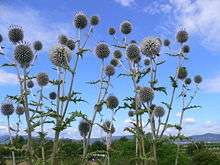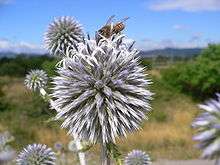Echinops sphaerocephalus
Echinops sphaerocephalus, known by the common names glandular globe-thistle,[2] great globe-thistle[3] or pale globe-thistle, is a Eurasian species of globe-thistle belonging to the thistle tribe within the sunflower family.
| Echinops sphaerocephalus | |
|---|---|
 | |
| Scientific classification | |
| Kingdom: | Plantae |
| Clade: | Tracheophytes |
| Clade: | Angiosperms |
| Clade: | Eudicots |
| Clade: | Asterids |
| Order: | Asterales |
| Family: | Asteraceae |
| Genus: | Echinops |
| Species: | E. sphaerocephalus |
| Binomial name | |
| Echinops sphaerocephalus | |
| Synonyms[1] | |
|
Synonymy
| |
Description

Echinops sphaerocephalus is a glandular, woolly perennial herbaceous plant with an average height of 50–100 centimetres (20–39 in), occasionally reaching 200 cm (80 inches).[4]
Its erect branching, gray, slightly wrinkled and hairy stems bear the occasional large, soft, sharply toothed, sharp-lobed pointed green leaves. They are sticky hairy above, and white woolly below.[4]
Atop each stem is an almost perfectly spherical inflorescence up to 6 cm in diameter, packed with white or blue-gray disc florets. It flowers from June until September.[4][5]
The flowers are pollinated by insects (usually bees, wasps and butterflies) (entomogamy) and are hermaphrodite (self fertilization or autogamy). The fruits are hairy cylindrical achenes about 7 to 8 mm long. They ripen from September through October. The seeds are dispersed by wind (anemochory).[4]
Distribution
This species is widespread across much of Eurasia but it lives on other continents where it was introduced, including North America where it is a widespread weed.[4][6][3] It is very common in the mountains of southern France and southern and central Europe.[7]
Habitat
It grows in sunny, rocky or brushy places in more or less mineral rich soils at an altitude of 0–400 metres (0–1,312 ft) above sea level.
- Subspecies[1]
- Echinops sphaerocephalus subsp. albidus (Boiss. et Spruner) Kozu.
- Echinops sphaerocephalus subsp. sphaerocephalus
- Echinops sphaerocephalus subsp. taygeteus (Boiss. & Heldr.) Kožuharov
Gallery
 Illustration of Echinops sphaerocephalus from Flora von Deutschland, Österreich und der Schweiz, 1885
Illustration of Echinops sphaerocephalus from Flora von Deutschland, Österreich und der Schweiz, 1885- Close-up on flowers of Echinops sphaerocephalus
- Inflorescence of Echinops sphaerocephalus pollinated by a butterfly
- Leaf of Echinops sphaerocephalus
References
- The Plant List, Echinops sphaerocephalus L.
- "BSBI List 2007". Botanical Society of Britain and Ireland. Archived from the original (xls) on 2015-01-25. Retrieved 2014-10-17.
- Flora of North America, Great globe-thistle, boulette commune, Echinops sphaerocephalus Linnaeus, Sp. Pl. 2: 814. 1753.
- Flora of China, 蓝刺头 lan ci tou Echinops sphaerocephalus Linnaeus
- Rose, Francis (1981). The Wild Flower Key. Frederick Warne & Co. pp. 386–387. ISBN 0-7232-2419-6.
- Biota of North America Program 2014 county distribution map
- Altervista Flora Italiana, Cardo pallotta maggiore, drüsige Kugeldistel, bolltistel, Echinops sphaerocephalus L. includes photos and European distribution map
External links
| Wikimedia Commons has media related to Echinops sphaerocephalus. |
| Wikispecies has information related to Echinops sphaerocephalus |
- ASTERACEAE, SUNFLOWER FAMILY, The Jepson Manual, University of California
- United States Department of Agriculture Plants Profile
- Globe Thistle, Ontario Weeds
- Echinops sphaerocephalus, alterVISTA
- Czech Botany